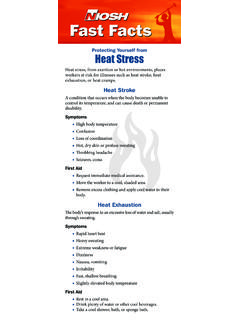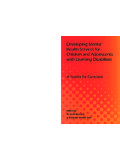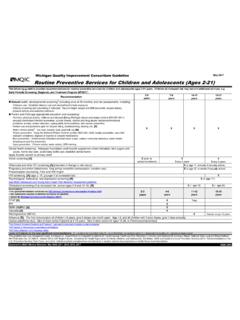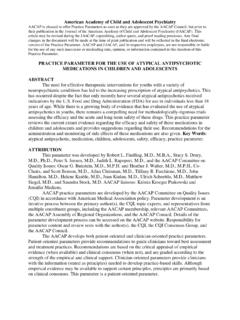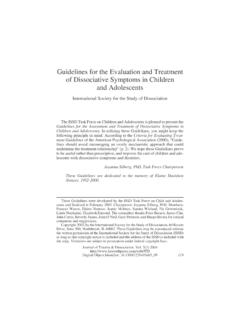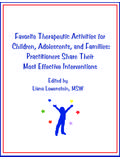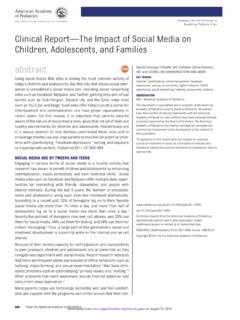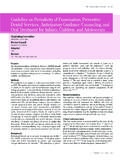Transcription of 2018 Combined Recommended Immunization …
1 Recommended Immunization schedule for children and Adolescents Aged 18 Years or Younger, UNITED STATES, 2018. The table below shows vaccine acronyms, and brand names for vaccines routinely recommend- ed for children and adolescents. The use of trade names in this Immunization schedule is for Consult relevant ACIP statements for detailed recommendations identification purposes only and does not imply endorsement by the ACIP or CDC. ( ). Vaccine type Abbreviation Brand(s). When a vaccine is not administered at the Recommended age, Diphtheria, tetanus, and acellular pertussis vaccine DTaP Daptacel Infanrix administer at a subsequent visit. Diphtheria, tetanus vaccine DT No Trade Name Use combination vaccines instead of separate injections when Haemophilus influenzae type B vaccine Hib (PRP-T) ActHIB. appropriate. Hib (PRP-OMP). Hiberix PedvaxHIB. Report clinically significant adverse events to the Vaccine Adverse Hepatitis A vaccine HepA Havrix Event Reporting System (VAERS) online ( ) or by Vaqta Hepatitis B vaccine HepB Engerix-B.
2 Telephone (800-822-7967). Recombivax HB. Report suspected cases of reportable vaccine-preventable diseases Human papillomavirus vaccine HPV Gardasil 9. to your state or local health department. Influenza vaccine (inactivated) IIV Multiple For information about precautions and contraindications, see www. Measles, mumps, and rubella vaccine MMR M-M-R II. Meningococcal serogroups A, C, W, Y vaccine MenACWY-D Menactra MenACWY-CRM Menveo Meningococcal serogroup B vaccine MenB-4C Bexsero MenB-FHbp Trumenba Approved by the Pneumococcal 13-valent conjugate vaccine PCV13 Prevnar 13. Pneumococcal 23-valent polysaccharide vaccine PPSV23 Pneumovax Advisory Committee on Immunization Practices Poliovirus vaccine (inactivated) IPV IPOL. ( ) Rotavirus vaccines RV1 Rotarix RV5 RotaTeq American Academy of Pediatrics Tetanus, diphtheria, and acellular pertussis vaccine Tdap Adacel ( ) Boostrix Tetanus and diphtheria vaccine Td Tenivac No Trade Name American Academy of Family Physicians Varicella vaccine VAR Varivax ( ).
3 Combination Vaccines DTaP, hepatitis B and inactivated poliovirus vaccine DTaP-HepB-IPV Pediarix American College of Obstetricians and Gynecologists DTaP, inactivated poliovirus and Haemophilus influenzae DTaP-IPV/Hib Pentacel ( ) type B vaccine This schedule includes recommendations in effect as of January 1, 2018. DTaP and inactivated poliovirus vaccine DTaP-IPV Kinrix Quadracel Measles, mumps, rubella, and varicella vaccines MMRV ProQuad Department of Health and Human Services Centers for Disease Control and Prevention Figure 1. Recommended Immunization schedule for children and Adolescents Aged 18 Years or Younger United States, 2018. (FOR THOSE WHO FALL BEHIND OR START LATE, SEE THE CATCH-UP schedule [FIGURE 2]). These recommendations must be read with the footnotes that follow. For those who fall behind or start late, provide catch-up vaccination at the earliest opportunity as indicated by the green bars in Figure 1. To determine minimum intervals between doses, see the catch-up schedule (Figure 2).
4 School entry and adolescent vaccine age groups are shaded in gray. 19-23. Vaccine Birth 1 mo 2 mos 4 mos 6 mos 9 mos 12 mos 15 mos 18 mos 2-3 yrs 4-6 yrs 7-10 yrs 11-12 yrs 13-15 yrs 16 yrs 17-18 yrs mos Hepatitis B1 (HepB) 1st dose 2nd dose 3rd dose Rotavirus2 (RV) RV1 (2-dose See 1st dose 2nd dose footnote 2. series); RV5 (3-dose series). Diphtheria, tetanus, & acellular 1st dose 2nd dose 3rd dose 4th dose 5th dose pertussis3 (DTaP: <7 yrs). Haemophilus influenzae type b4 See 3rd or 4th dose, 1st dose 2nd dose footnote 4 See footnote 4. (Hib). Pneumococcal conjugate5. 1st dose 2nd dose 3rd dose 4th dose (PCV13). Inactivated poliovirus6. 1st dose 2nd dose 3rd dose 4th dose (IPV: <18 yrs). Annual vaccination (IIV). Influenza7 (IIV) Annual vaccination (IIV) 1 or 2 doses 1 dose only Measles, mumps, rubella8 (MMR) See footnote 8 1st dose 2nd dose Varicella9 (VAR) 1st dose 2nd dose Hepatitis A1 0 (HepA) 2-dose series, See footnote 10.
5 Meningococcal1 1 (MenACWY-D. See footnote 11 1st dose 2nd dose >9 mos; MenACWY-CRM 2 mos). Tetanus, diphtheria, & acellular Tdap pertussis1 3 (Tdap: >7 yrs). See footnote Human papillomavirus1 4 (HPV) 14. See footnote 12. Meningococcal B1 2. Pneumococcal polysaccharide5. See footnote 5. (PPSV23). Range of Recommended Range of Recommended ages Range of Recommended ages Range of Recommended ages for non-high-risk No recommendation ages for all children for catch-up Immunization for certain high-risk groups groups that may receive vaccine, subject to individual clinical decision making NOTE: The above recommendations must be read along with the footnotes of this schedule . FIGURE 2. Catch-up Immunization schedule for persons aged 4 months 18 years who start late or who are more than 1 month behind United States, 2018. The figure below provides catch-up schedules and minimum intervals between doses for children whose vaccinations have been delayed.
6 A vaccine series does not need to be restarted, regardless of the time that has elapsed between doses. Use the section appropriate for the child's age. Always use this table in conjunction with Figure 1 and the footnotes that follow. children age 4 months through 6 years Minimum Minimum Interval Between Doses Vaccine Age for Dose 1 Dose 1 to Dose 2 Dose 2 to Dose 3 Dose 3 to Dose 4 Dose 4 to Dose 5. Hepatitis B1 Birth 4 weeks 8 weeks and at least 16 weeks after first dose. Minimum age for the final dose is 24 weeks. 6 weeks Maximum age 4 weeks 4 weeks2. Rotavirus2 for first dose is Maximum age for final dose is 8 months, 0 days. 14 weeks, 6 days Diphtheria, tetanus, and 6 weeks 4 weeks 4 weeks 6 months 6 months3. acellular pertussis3. 4 weeks4. if current age is younger than 12 months and first dose was administered at younger than age 7 months, 4 weeks and at least 1 previous dose was PRP-T (ActHib, Pentacel, Hiberix) or unknown.
7 If first dose was administered 8 weeks and age 12 through 59 months (as final dose)4. before the 1st birthday. 8 weeks (as final dose). if current age is younger than 12 months and first dose was administered at age 7 through 11. 8 weeks (as final dose) months; This dose only necessary for chil- Haemophilus influenzae 6 weeks if first dose was administered at age OR dren age 12 through 59 months type b4 12 through 14 months. who received 3 doses before the 1st if current age is 12 through 59 months and first dose was administered before the 1st birthday, and birthday. No further doses needed if first second dose administered at younger than 15 months;. dose was administered at age 15 OR. months or older. if both doses were PRP-OMP (PedvaxHIB; Comvax) and were administered before the 1st birthday. No further doses needed if previous dose was administered at age 15 months or older. 4 weeks if first dose administered before the 1st birthday.
8 4 weeks if current age is younger than 12 months and previous dose given at <7 months old. 8 weeks (as final dose). 8 weeks (as final dose for healthy This dose only necessary for chil- children ) 8 weeks (as final dose for healthy children ). Pneumococcal dren aged 12 through 59 months 6 weeks if first dose was administered at the if previous dose given between 7-11 months (wait until at least 12 months old);. conjugate5 who received 3 doses before age 12. 1st birthday or after. OR months or for children at high risk No further doses needed if current age is 12 months or older and at least 1 dose was given before age 12 months. who received 3 doses at any age. for healthy children if first dose was No further doses needed for healthy children if previous dose administered at age 24 months or older. administered at age 24 months or older. 4 weeks6 if current age is < 4 years 6 months6 (minimum age 4 years for Inactivated poliovirus6 6 weeks 4 weeks6.)
9 6 months (as final dose) if current age is 4 years or older final dose). Measles, mumps, rubella8 12 months 4 weeks Varicella9 12 months 3 months Hepatitis A10 12 months 6 months Meningococcal11. (MenACWY-D 9 mos; 6 weeks 8 weeks11 See footnote 11 See footnote 11. MenACWY-CRM 2 mos). children and adolescents age 7 through 18 years Meningococcal11 Not Applicable 8 weeks11. (MenACWY-D 9 mos; (N/A). MenACWY-CRM 2 mos). 4 weeks Tetanus, diphtheria; if first dose of DTaP/DT was administered before the 1st birthday. 6 months if first dose of DTaP/DT. tetanus, diphtheria, and 7 years13 4 weeks was administered before the 1st acellular pertussis13 6 months (as final dose) birthday. if first dose of DTaP/DT or Tdap/Td was administered at or after the 1st birthday. Human papillomavirus14 9 years Routine dosing intervals are Hepatitis A10 N/A 6 months Hepatitis B1 N/A 4 weeks 8 weeks and at least 16 weeks after first dose. A fourth dose of IPV is indicated if all 6 months6 previous doses were administered Inactivated poliovirus6 N/A 4 weeks A fourth dose is not necessary if the third dose was administered at age 4 years or older and at least 6 months at <4 years or if the third dose was after the previous dose.
10 Administered <6 months after the second dose. Measles, mumps, rubella8 N/A 4 weeks 3 months if younger than age 13. Varicella9 N/A years. 4 weeks if age 13 years or older. NOTE: The above recommendations must be read along with the footnotes of this schedule . Figure 3. Vaccines that might be indicated for children and adolescents aged 18 years or younger based on medical indications HIV infection CD4+ count . <15% or 15% or Immunocompromised total CD4 total CD4 Kidney failure, end- CSF leaks/ Asplenia and persistent Chronic status (excluding HIV cell count of cell count of stage renal disease, on Heart disease, cochlear complement component liver VACCINE INDICATION Pregnancy infection) <200/mm3 200/mm3 hemodialysis chronic lung disease implants deficiencies disease Diabetes Hepatitis B1. Rotavirus2. SCID*. Diphtheria, tetanus, & acellular pertussis3. (DTaP). Haemophilus influenzae type b4. Pneumococcal conjugate5. Inactivated poliovirus6.









